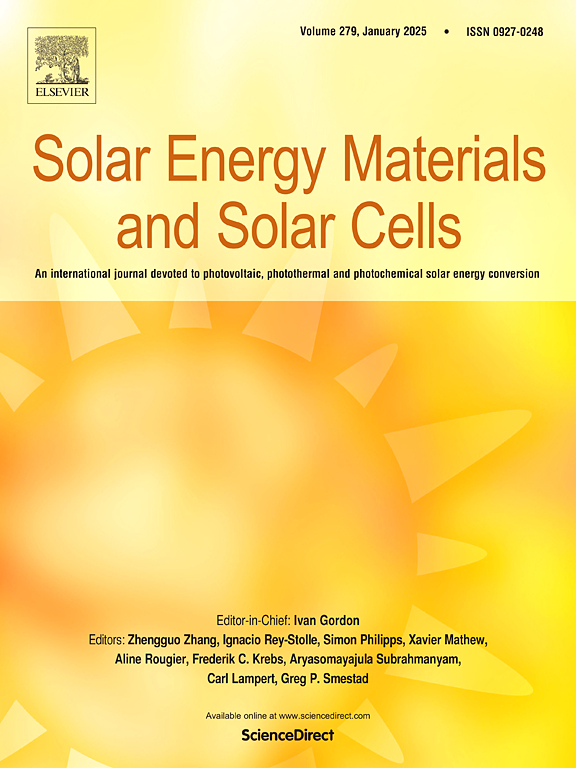Silver-lean screen-printing metallisation for industrial TOPCon solar cells: Enabling an 80 % reduction in silver consumption
IF 6.3
2区 材料科学
Q2 ENERGY & FUELS
引用次数: 0
Abstract
The photovoltaic (PV) industry is transitioning from Passivated Emitter and Rear Contact (PERC) technology to Tunnel Oxide Passivated Contact (TOPCon) solar cells, which offer higher efficiency but require significantly more silver for screen-printed metallisation. This increased silver demand presents challenges for both manufacturing costs and resource sustainability, particularly as PV production scales towards the terawatt level. To address this, we present a silver-lean screen-printing metallisation technology that substantially reduces silver consumption in industrial TOPCon solar cells while maintaining their excellent efficiencies. Our approach utilises a two-step printing process, where a small amount of silver paste is printed as dashes to form contacts with the silicon surface, followed by the printing of floating fingers and busbars with alternative silver-lean pastes. Using this approach, we achieved an 85 % reduction in rear-side silver usage in 25 %-efficient TOPCon cells, with only a marginal efficiency gap (∼0.1 %) compared to TOPCon cells with industrial standard metallisation design. We also demonstrated an ultra-low silver consumption of 2 mg/W by implementing our design on both sides of TOPCon cells. With further optimisations in dash pattern design and printing processes, we expect these cells to reach efficiencies comparable to industrial TOPCon cells with standard metallisation designs. Additionally, we identified a negative interaction between Ag dashes and Al fingers during co-firing, highlighting the need for paste development to take full advantage of this metallisation approach. This work demonstrates a practical and industry-relevant approach to reducing silver consumption in screen-printed metallisation, paving the way for more sustainable and cost-effective manufacturing of TOPCon solar cells.
用于工业TOPCon太阳能电池的贫银丝网印刷金属化:使银消耗减少80%
光伏(PV)行业正在从钝化发射极和后触点(PERC)技术过渡到隧道氧化物钝化触点(TOPCon)太阳能电池,这种技术可以提供更高的效率,但需要更多的银用于丝网印刷金属化。白银需求的增加对制造成本和资源可持续性都提出了挑战,特别是当光伏生产规模达到太瓦水平时。为了解决这个问题,我们提出了一种低银丝网印刷金属化技术,该技术大大减少了工业TOPCon太阳能电池的银消耗,同时保持了其优异的效率。我们的方法采用两步印刷工艺,其中少量的银膏被印刷成与硅表面形成接触的划线,然后用替代的银膏印刷浮动的手指和母线。使用这种方法,我们在25%效率的TOPCon电池中实现了后部银使用量减少85%,与工业标准金属化设计的TOPCon电池相比,只有边际效率差距(~ 0.1%)。通过在TOPCon电池的两侧实施我们的设计,我们还展示了2 mg/W的超低银消耗。随着划线图案设计和印刷工艺的进一步优化,我们希望这些电池达到与标准金属化设计的工业TOPCon电池相当的效率。此外,我们发现在共烧过程中,银划和铝指之间存在负相互作用,这突出了膏体开发的必要性,以充分利用这种金属化方法。这项工作展示了一种实用的、与工业相关的方法,可以减少丝网印刷金属化过程中的银消耗,为更可持续、更经济地制造TOPCon太阳能电池铺平了道路。
本文章由计算机程序翻译,如有差异,请以英文原文为准。
求助全文
约1分钟内获得全文
求助全文
来源期刊

Solar Energy Materials and Solar Cells
工程技术-材料科学:综合
CiteScore
12.60
自引率
11.60%
发文量
513
审稿时长
47 days
期刊介绍:
Solar Energy Materials & Solar Cells is intended as a vehicle for the dissemination of research results on materials science and technology related to photovoltaic, photothermal and photoelectrochemical solar energy conversion. Materials science is taken in the broadest possible sense and encompasses physics, chemistry, optics, materials fabrication and analysis for all types of materials.
 求助内容:
求助内容: 应助结果提醒方式:
应助结果提醒方式:


